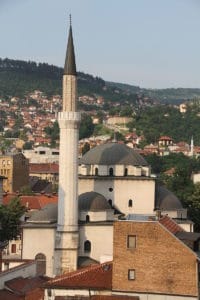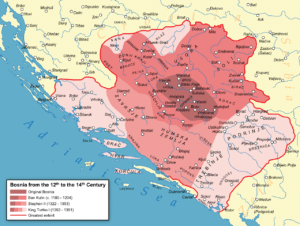Following his death in 1391 however, Bosnia fell into a long period of decline. The Ottoman Empire had started its conquest of Europe and posed a major threat to the Balkans throughout the first half of the 15th century. Finally, after decades of political and social instability, the Kingdom of Bosnia ceased to exist in 1463 after its conquest by the Ottoman Empire.
Ottoman Bosnia (1463–1878):
The Ottoman conquest of Bosnia marked a new era in the country’s history and introduced drastic changes in the political and cultural landscape. The Ottomans incorporating Bosnia as an integral province of the Ottoman Empire with its historical name and territorial integrity.

Within Bosnia the Ottomans introduced a number of key changes in the territory’s socio-political administration; including a new landholding system, a reorganization of administrative units, and a complex system of social differentiation by class and religious affiliation.
The four centuries of Ottoman rule also had a drastic impact on Bosnia’s population make-up, which changed several times as a result of the empire’s conquests, frequent wars with European powers, forced and economic migrations, and epidemics. A native Slavic-speaking Muslim community emerged and eventually became the largest of the ethno-religious groups due to lack of strong Christian church organizations and continuous rivalry between the Orthodox and Catholic churches, while the indigenous Bosnian Church disappeared altogether (ostensibly by conversion of its members to Islam). The Ottomans referred to them as kristianlar while the Orthodox and Catholics were called gebir or kafir, meaning “unbeliever”. The Bosnian Franciscans (and the Catholic population as a whole) were protected by official imperial decrees and in accordance and full extent of Ottoman laws, however in effect, these often merely affected arbitrary rule and behavior of powerful local elite.
As the Ottoman Empire continued their rule in the Balkans (Rumelia), Bosnia was somewhat relieved of the pressures of being a frontier province, and experienced a period of general welfare. A number of cities, such as Sarajevo and Mostar, were established and grew into regional centers of trade and urban culture and were then visited by Ottoman traveler Evliya Çelebi in 1648. Within these cities, various Ottoman Sultans financed the construction of many works of Bosnian architecture such as the country’s first library in Sarajevo, madrassas, a school of Sufi philosophy, and a clock tower (Sahat Kula), bridges such as the Stari Most, the Tsar’s Mosque and the Gazi Husrev-beg’s Mosque.

However, by the late 17th century the Empire’s military misfortunes caught up with the country, and the end of the Great Turkish War with the treaty of Karlowitz in 1699 again made Bosnia the Empire’s westernmost province. The 18th century was marked by further military failures, numerous revolts within Bosnia, and several outbursts of plague.
The Porte’s efforts at modernizing the Ottoman state were met with distrust growing to hostility in Bosnia, where local aristocrats stood to lose much through the proposed Tanzimat reforms. This, combined with frustrations over territorial, political concessions in the north-east, and the plight of Slavic Muslim refugees arriving from the Sanjak of Smederevo into Bosnia Eyalet, culminated in a partially unsuccessful revolt by Husein Gradaščević, who endorsed a Bosnia Eyalet autonomous from the authoritarian rule of the Ottoman Sultan Mahmud II, who persecuted, executed and abolished the Janissaries and reduced the role of autonomous Pashas in Rumelia. Mahmud II sent his Grand Vizier to subdue Bosnia Eyalet and succeeded only with the reluctant assistance of Ali-paša Rizvanbegović. Related rebellions were extinguished by 1850, but the situation continued to deteriorate.
